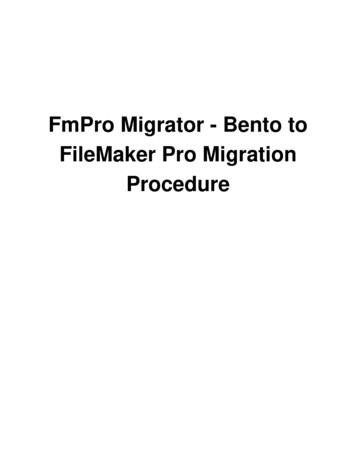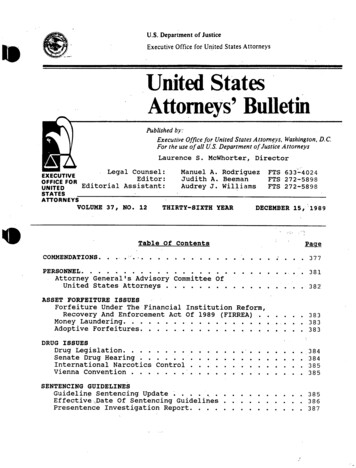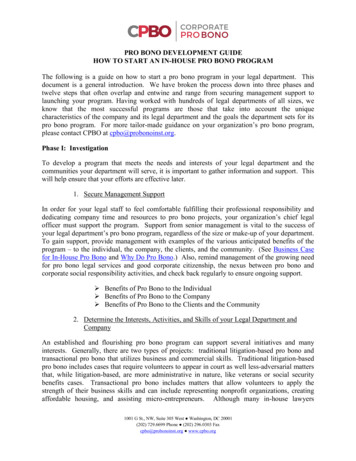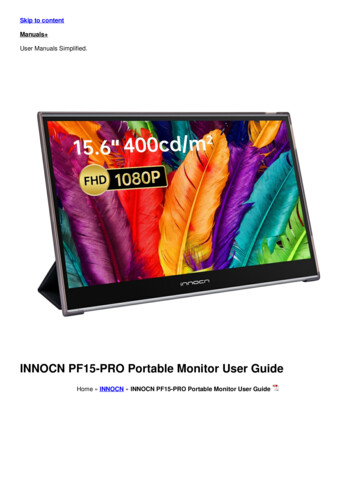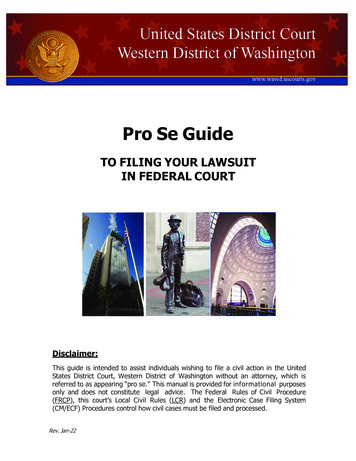
Transcription
Pro Se GuideTO FILING YOUR LAWSUITIN FEDERAL COURTDisclaimer:This guide is intended to assist individuals wishing to file a civil action in the UnitedStates District Court, Western District of Washington without an attorney, which isreferred to as appearing “pro se.” This manual is provided for informational purposesonly and does not constitute legal advice. The Federal Rules of Civil Procedure(FRCP), this court’s Local Civil Rules (LCR) and the Electronic Case Filing System(CM/ECF) Procedures control how civil cases must be filed and processed.Rev. Jan-22
Table of ContentsPart One . 4 BEFORE YOU FILE YOUR CASE . 4 Consider ways to resolve your dispute or problem outside of court . 4 Are you in the correct court? . 5 Types of cases filed in federal court . 6 Are your claims timely? . 7 Other issues to consider. 7 Part Two. 8 FILING YOUR CASE . 8 Rules that you must follow . 8 Required forms to file a new case . 9 Complaint . 9 Civil Cover Sheet . 10 Summons . 13 Application to Proceed In Forma Pauperis (IFP) . 14 Application for Court-Appointed Counsel . 14 Where to file your complaint . 15 What does the Clerk’s Office do with the case information? . 16 Options for Payment of Copy and Filing Fees . 17 What the Clerk’s Office can and cannot do . 17 Part Three . 18 ELECTRONIC FILING SYSTEM . 18 Registration Requirements . 19 How to Register . 19 E-Filer and E-Service Registration . 20 Complete the Registration Form. 20 PACER (Public Access to Court Electronic Records) . 21 Electronic Filing Assistance . 21 Electronic Filing Terminology . 22 Pro Se Guide to Filing Your Lawsuit in Federal Court (Rev. Jan-22)Page 2
Part Four . 23 SERVICE OF SUMMONS AND COMPLAINT . 23 What does service mean? . 23 When must service be done? . 23 How should summons be presented? . 24 Who must be served? . 24 Who serves the documents?. 24 How does the Court know when summons have been served? . 24 Part Five . 25 WHAT HAPPENS AFTER YOUR CASE IS FILED? . 25 Case assignment . 25 Defendants do not file an answer . 26 Defendants file an answer . 26 Pretrial process . 26 Discovery . 26 Dispositive motions. 27 Trial process . 27 Judgment . 29 Notice of Appeal . 29 Part Six. 30 FILING DOCUMENTS AFTER YOUR CASE IS OPEN . 30 Format of documents . 30 Motions . 31 Noting dates . 31 Sealed documents . 33 Oral argument . 33 Change of Contact Information . 33 Part Seven . 34 RESOURCES THAT MAY HELP YOU . 34 Washington State Legal Resources. 34 Federal Civil Rights Legal Clinic. 36 Pro Se Guide to Filing Your Lawsuit in Federal Court (Rev. Jan-22)Page 3
Part OneBEFORE YOU FILE YOUR CASEConsider ways to resolve your dispute or problem outside of courtAre you having a disagreement with another person, business or governmentagency? Are you thinking about going to court to ask a judge to resolve adisagreement or solve a problem for you?Federal court is one type of court that can help people resolve disputes. When twoor more people (or a person, business or government agency) have a disagreementand want a judge to resolve the dispute, it’s called a “case” or a “lawsuit.”Before you decide to file a case in federal court, you may want to consider otherways to solve your dispute. Try talking to the person, business, or government agency thatyou feel has done something wrong by asking them to fix theproblem. Many government agencies have requirements or special rules youmust follow before filing a case in federal court. Seek help from other sources. There are a number of local and statewide agencies that may be able to assist you. Contact an attorney. An attorney will be able to help you determine iffederal court is the right place to solve your problem and provide you withinformation about legal resources available in the community.Pro Se Guide to Filing Your Lawsuit in Federal Court (Rev. Jan-22)Page 4
You also have the right to file your case without an attorney, which is known asproceeding, “pro se.” Appearing pro se means that you will be representing yourselfwithout the assistance of a lawyer.If you decide to represent yourself, the court will treat you the same as it would anattorney. You will be expected to state your issues clearly and concisely, meet alldeadlines, and follow the court rules.Are you in the correct court?Before filing a case in federal court, you first need to make sure that you arefiling it in the correct court. This can be especially important if you are working witha deadline for certain statutes of limitations. Filing your case in the wrong court mayaffect whether or not you meet those required deadlines.Before filing your case in federal court, you may want to ask yourself the followingquestions.Is your case about a divorce, child custody, adoption, name change,landlord-tenant dispute or a will?If so, you are likely in the wrong court. State courts generally hear family lawmatters and landlord-tenant disputes. You can learn more about WashingtonState Courts at www.courts.wa.gov. If in doubt, contact an attorney for legaladvice about your specific situation. The Clerk’s Office cannot make thisdetermination for you.Is your case about a federal law, the denial of Social Securitybenefits, other federal benefits or a decision by a federal agency?If so, you are likely in the right court.Should you file your case in Tacoma or Seattle?The U.S. District Court for the Western District of Washington has courthousesin Seattle and Tacoma. Where you file your case depends on the countyin which the claim arose or where the defendant(s) reside, as established bythe Court’s Local Civil Rules (LCR).A list of counties and their corresponding jurisdictional courthouses can befound on the following page.Pro Se Guide to Filing Your Lawsuit in Federal Court (Rev. Jan-22)Page 5
If the defendant(s) reside in or the incident occurred in one of the followingcounties, you should file your case in Seattle.xxxxxxIsland CountyKing CountySan Juan CountySkagit CountySnohomish CountyWhatcom CountyIf the defendant(s) reside in or the incident occurred in one of the followingcounties, you should file your case in Tacoma.xxxxxxxxxxxxxClallam CountyClark CountyCowlitz CountyGrays Harbor CountyJefferson CountyKitsap CountyLewis CountyMason CountyPacific CountyPierce CountySkamania CountyThurston CountyWahkiakum CountyTypes of cases filed in federal courtFederal courts are courts of limited jurisdiction and therefore, the following typesof cases may be filed here.1. Cases where the United States government is a party to theaction.Federal courts hear lawsuits involving the Social Security Administration,Veterans Administration or cases against a federal agency, such as theUnited States Postal Service or the Internal Revenue Service.2. Cases brought under federal laws.Federal courts hear specific types of cases arising under the United StatesConstitution and federal laws such as damages at sea, federal tax mattersand other areas. Some federal laws may duplicate some state laws, suchas civil rights matters.Pro Se Guide to Filing Your Lawsuit in Federal Court (Rev. Jan-22)Page 6
3. Cases where the parties reside in different states.Lawsuits between parties residing in different states are governed by“diversity” jurisdiction. For example, if you live in Washington andyou file a lawsuit against a defendant who lives in Oregon, the casewould be considered diversity.Diversity cases must involve a claim of damages over 75,000. If you arenot seeking more than that amount, or your case does not involve federallaw of a government defendant, you may need to file your claim in statecourt.Are your claims timely?The period of time set by law in which a lawsuit must be filed is called the “statuteof limitations.” This period of time usually begins when the injury occurs or aright has been violated. If you fail to bring your claim within the timeframe allowedby a specific statute, your lawsuit may be dismissed.Other issues to considerBefore filing your case in federal court, please be aware of the following:Frivolous or harassing lawsuitsThe Federal Rules of Civil Procedures, FRCP 11(b), prohibits the filing oflawsuits that are clearly frivolous or filed just to harass someone. If the judgedetermines that you have filed a lawsuit for an improper or unnecessaryreason, sanctions may be imposed against you, including ordering that youpay the legal fees of the party you sued.What happens if you lose?If you lose your case, the winning party may ask that you be ordered to payattorney fees. The winning party is also entitled to seek certain costs whichwere incurred during the lawsuit. These costs can include depositiontranscript fees, witness fees, copy expenses, etc. These fees may add up tothousands of dollars. It is very common for a winning party to seek costsfrom the losing party.Pro Se Guide to Filing Your Lawsuit in Federal Court (Rev. Jan-22)Page 7
Part TwoFILING YOUR CASEBefore a judge can address the facts you are contesting, you must submit the requireddocuments to open a case in the United States District Court for the Western District ofWashington.Rules that you must followBefore you file a case, you should begin by reviewing the local and federal rules thatgovern the filing of a case in this court. By appearing pro se and representingyourself, the judge will expect you to be familiar with the court rules that governthe filing of a civil lawsuit in federal court.1. Federal Rules of Civil Procedure (FRCP)The Federal Rules of Civil Procedure (FRCP) govern court procedures forcivil cases. A link to the federal rules can be found atwww.law.cornell.edu/rules/frcp2. Local Civil Rules (LCR) for the Western District of WashingtonThis is a collection of local rules that are written for the practice of law inthe United States District Court for the Western District of Washington.They are published in addition to the federal rules. Be aware that localrules differ from court to court, so you should refer to the local rules ofthe Western District of Washington.Pro Se Guide to Filing Your Lawsuit in Federal Court (Rev. Jan-22)Page 8
The Local Civil Rules (LCR) and Federal Rules of Civil Procedures (FRCP)can be found on our website at . Western District of Washington’s Electronic(CM/ECF)FilingSystemInformation about how to register to file and receive documentselectronically through the court’s Electronic Filing System (CM/ECF) canbe found in Part Three of this guide or on our website atwawd.uscourts.gov/attorneys/cmecfRequired forms to file a new caseThe following documents are required to file a new case.1)Complaint form2)Civil Cover Sheet3)Payment of the filing fee ( 402.00) or submittal of an Application to ProceedIn Forma Pauperis – commonly referred to as an “IFP” – requesting that thecourt waive the filing fee. Additional information about how to submit an IFPcan be found on page 14.ComplaintTo file a new case, you must first complete a document called a “Complaint.”A complaint is a legal document that describes why you believe the defendant(s)violated the law and what you want the court to do about it.To file a case, you must follow the procedures outlined below.1. Select the correct complaint form based on the type of case youare filing. Complaint forms can be found on our website atwww.wawd.uscourts.gov/court-forms under “Self-Representation”or by calling the Clerk’s Office in Seattle (206-370-8400) or Tacoma(253-882-3800) to request a complaint form be mailed to you.2. Documents must be typed or neatly written in blue or black ink(no pencils) on white, 8½ x 11 paper. Do not write on both sidesof the paper. You must include your name, address and phonenumber on each document submitted.3. All documents must be dated and signed with an originalsignature, as established by FRCP 11(a).Pro Se Guide to Filing Your Lawsuit in Federal Court (Rev. Jan-22)Page 9
4. In the body of the complaint, explain in detail what happened, whereit happened, when it happened, how it happened and who wasinvolved.5. You may also choose to supplement your complaint in the form ofan “exhibit.” An exhibit is a document, record or physical object.For example, medical reports, transcripts or photographs.6. Documents with personal identifiers must be redacted (blacked out)or removed before they are filed, as established by LCR 5.2(a).xDates of birth (redact to year of birth)xNames of minor children under 18 (redact to initials)xSocial security numbers (remove entirely)xFinancial account numbers (redact to last four digits)xTaxpayer identification numbers (remove entirely)xPassport ID numbers (remove entirely)xDriver license numbers (remove entirely)Civil Cover SheetA “Civil Cover Sheet” is a document that provides the court with basic informationabout your case and must be filed when you submit your initial documents, asestablished by LCR 3(a). The Civil Cover Sheet can be found at the end of thisguide or on our website at www.wawd.uscourts.gov/court-forms under “Civil.”Section I - PartiesSection 1(a): Your name and name(s) of the defendant(s).Section 1(b): Your county and county of first listed defendant.Section 1(c): Since you are appearing pro se, write your name,address and phone number under “Attorneys.”Pro Se Guide to Filing Your Lawsuit in Federal Court (Rev. Jan-22)Page 10
Section II – Basis of JurisdictionThis section lets the court know what type of case you are filing.1. Government – Plaintiff: This box is for government agencies only.2. Government – Defendant: Mark this box if you are filing a caseagainst a federal agency or the United States government.3. Federal Question: Mark this box if your case is about a federal law.4. Diversity: Mark this box if the defendant(s) live in another state orcountry; is not a federal agency or if your case involves a claim valuedover 75,000.Section III – Citizenship of Principal PartiesThis section is only used if you marked “Diversity” in Section II. Diversity refers tocases where the parties involved are from different states or countries. If“Diversity” was chosen, mark the correct box where you and the first listeddefendant(s) are located.Pro Se Guide to Filing Your Lawsuit in Federal Court (Rev. Jan-22)Page 11
Section IV – Nature of SuitYou can only choose one box. If your complaint includes multiple claims, select theone that most closely represents what your case is about.Section V – OriginThis section has several options to choose from. Origin (1) “Original Proceeding,”is frequently chosen as it indicates you are filing a new lawsuit. However, if you arefiling a case that you are removing from state court to federal court, you shouldchoose (2) “Removed from State Court.”Section VI – Cause of ActionIn this section, you will provide a brief statement explaining what your case is about.Section VII – Requested in ComplaintThe only information you will complete in this section is the jury demand box, asestablished by LCR 38(b).Pro Se Guide to Filing Your Lawsuit in Federal Court (Rev. Jan-22)Page 12
Section VIII – Related Case(s) If AnyComplete this section if you currently have or have had cases in this court or otherfederal courts with the same defendant(s). If so, add the name of the judge andcase number to the form. You are also required to file a “Notice of RelatedCases,” listing the case information. As the court does have a general form to use,you may create your own.Sign and Date FormBecause you are appearing pro se (i.e., acting as your own attorney), you must signand date the box at the bottom of form under, “Signature of Attorney of Record.”SummonsA “Summons” is a document that demands that the defendant(s) respond to yourcomplaint. You must fill out the required fields on the summons form beforesubmitting it to the court.The form may be found on our website atwww.wawd.uscourts.gov/court-forms under “Civil” and at the end of this guide.If you pay the filing fee, summons can be issued immediately. If you file an IFP,summons will not be issued until the motion is granted and the clerk receivespermission from the court to do so. The clerk will then sign and adhere the court’sseal to the summons. The clerk can only issue summons for defendant(s) listed onthe complaint.After summons have been issued and the defendant(s) have been “served” a copyof the complaint and accompanying documents, you must file a document calleda “Proof of Service,” which is on the second page of the summons form. Thisdocument provides proof to the court that the defendant(s) have been properlyserved with your lawsuit. See Part Four of this guide for more information.If you prefer to wait and have summons issued later, you may submit them with a“Praecipe” form. A praecipe is a document asking the court to take official actionon a specific request.Praecipe forms can be found on our website atwww.wawd.uscourts.gov/court-forms under “Civil.”Pro Se Guide to Filing Your Lawsuit in Federal Court (Rev. Jan-22)Page 13
Application to Proceed In Forma Pauperis (IFP)The filing fee to open a case in federal court is 402.00.If you cannot afford to pay the filing fee, you can apply to have the fee "waived,"which means your case may proceed without payment of the filing fee. In orderto make that request, you must complete an “Application to Proceed In FormaPauperis” – commonly referred to as an “IFP” – and submit it with your initiatingdocuments.It is very important to fill out the form completely as the judge will use thisinformation to determine if you have the financial ability to pay the filing fee.Once a decision has been made, a copy of the order will be mailed to you at theaddress listed on the complaint. Summons will not be issued until the IFP has beengranted and the court gives the clerk permission to do so.The IFP form can be found at the end of this packet or on our website atwww.wawd.uscourts.gov/court-forms under “Self-Representation.”Application for Court-Appointed CounselIf you cannot afford an attorney but would like to request one be appointed, you cansubmit an “Application for Court-Appointed Counsel.” Although this optionis available, there is no right to representation in civil matters and no guarantee thatthe judge will appoint an attorney in your case.The judge may base his or her decision on several factors, including but not limitedto:1. Do you have the financial ability to hire counsel?2. Have you made reasonable efforts to hire counsel on your own?3. Can you prepare and present your case without the help of anattorney?4. How complex is your case?To request an attorney, you must complete the correct form based on the type ofcase you are filing. One form is specifically for civil rights cases and the other foremployment discrimination cases. Both forms can be found at the end of thisguide and on our website at www.wawd.uscourts.gov/court-forms under “SelfRepresentation.” If your claims do not fall under either category, you can createyour own form and submit it to the court.Pro Se Guide to Filing Your Lawsuit in Federal Court (Rev. Jan-22)Page 14
Where to file your complaint1) In PersonThe Clerk’s Office window is open to the public Monday-Friday from 9am to4pm. Please make sure you have completed and signed all of the requiredforms before submitting them to the court.If you arrive outside of those hours, documents may be filed via the lockeddrop box located in the lobby of both courthouses. Once your case has beenopened, you will receive a letter in the mail with the case number and judgeassignment.2) By MailDocuments may also be mailed to the Seattle or Tacoma courthouse. Whereyou mail them is based on the county where the incident took place orwhere the defendant(s) reside (see page 6). After your case has beenopened, you will receive a letter with the case number and judgeassignment. All documents filed after the case has been assigned shouldbe mailed to the courthouse where your judge is located.SeattleTacomaU.S. District Court700 Stewart St., Suite 2310Seattle, WA 98101(206) 370-8400U.S. District Court1717 Pacific Ave., Room 3100Tacoma, WA 98402(253) 882-38003) E-mailYou also have the option of submitting new case documents electronically.Where you email them is based on the county where the incident took placeor where the defendant(s) reside (see page a:newcases.tacoma@wawd.uscourts.govYou are only permitted to e-mail documents when filing a new case. Once ajudge has been assigned, documents must be submitted in person, throughthe mail or via the court’s electronic filing system, if registered (see page 18).Pro Se Guide to Filing Your Lawsuit in Federal Court (Rev. Jan-22)Page 15
What does the Clerk’s Office do with the case information?If you pay the filing fee, the clerk will:1) Randomly assign a case number and judge, based on the countywhere the incident took place or where the defendant(s) reside.2) Social Security appeals are randomly assigned to judges in Seattleor Tacoma, regardless of where you reside.3) Issue summons, if submitted.If you file an IFP requesting that the court waive the filing fee, the clerkwill:1) Randomly assign a case number and judge, based on the countywhere the incident took place or where the defendant(s) reside.2) Social Security appeals are randomly assigned to judges in Seattleor Tacoma, regardless of their location.3) Summons will not be issued until an order is entered by the courtand the clerk is given permission to issue them.Pro Se Guide to Filing Your Lawsuit in Federal Court (Rev. Jan-22)Page 16
Options for Payment of Copy and Filing FeesThe Clerk’s Office accepts the following forms of payment:xVisa, MasterCard, American Express and DiscoverxPersonal checks, cashier checks and money ordersWhat the Clerk’s Office can and cannot doAlthough the clerk can answer most questions, we are legally prohibited fromproviding legal advice.We can: Answer general questions about how the court works, includingproviding you with the required forms to open a new case. Provide general information about court policies and procedures.We cannot: Give legal advice. This policy applies to all parties, includingattorneys. Tell you whether you should file a case or what information to includein your court pleadings. Talk to the judge for you or let you talk to the judge outside of court. Determine when a decision will be made on your IFP or otherpending motions as well as interpreting court orders. Interpret court rules.Pro Se Guide to Filing Your Lawsuit in Federal Court (Rev. Jan-22)Page 17
Part ThreeELECTRONIC FILING SYSTEMWhen filing a new case, you must either pay the 402.00 filing fee or submita Motion to Proceed In Forma Pauperis – referred to as an “IFP” – askingthat the court waive the filing fee.Once the filing fee has been paid or the court has granted your IFP, you have theoption of filing documents electronically using the Case Management/ElectronicCase Filing System, referred to as “CM/ECF.” This system allows you to filedocuments electronically without delivering them in person or through the mail. Italso allows you to receive and view via email everything that has been filed in yourcase by you, the judge, the defendants or any other parties in your case.Information about how to electronically file documents, the rules and proceduresthat must be followed and the ECF User Manual can be found on our website se. You will also find a CM/ECFPro Se Registration Form at the end of this guide. It is important that you reviewthe registration form carefully as it is your responsibility to comply with the court’selectronic filing procedures.For questions, please contact the ECF Support Team at (206) 370-8440, option#2or via email at cmecf@wawd.uscourts.gov.Pro Se Guide to Filing Your Lawsuit in Federal Court (Rev. Jan-22)Page 18
Registration RequirementsYou are not required to use the court’s electronic filing system. If you are notcomputer savvy or do not have access to a computer, we recommend that you fileyour documents in person or through the mail.The following requirements must be met to register for electronic filing:xThe filing fee has been paid or the Motion to Proceed In Forma Pauperis(IFP) has been granted.xYou are a party to the case for which you are applying for electronic filing.xYou meet the following technical requirements:1. A personal computer with Internet access.2. Internet Explorer or Firefox browser. Other browsers (Safari,Google Chrome; Microsoft Edge) may have functionality issueswith the court’s ECF system and are not supported.3. Software to convert your documents to PDF format (portabledocument format) OR a scanner set to 200 dpi (dots per inch)for scanning documents to PDF format.4. Adobe Acrobat Reader software to view and save documents inPDF format.5. Experience and knowledge of word processing applications,printers and the Internet.6. An email account to receive notices of filings and court orders.How to RegisterThe court offers two CM/ECF registration options:1.E-Filer and E-ServiceWith this service, you can electronically file documents through thecourt
2. Local Civil Rules (LCR) for the Western District of Washington This is a collection of local rules that are written for the practice of law in the United States District Court for the Western District of Washington. They are published in addition to the federal rules. Be aware that local rules differ from court to court, so you should refer .






